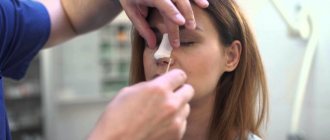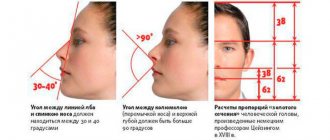The choice of correction method has a direct impact on several nuances:
- Width of the base of the bony vault;
- Width of the bridge of the nose;
- Height of the bridge of the nose.
Based on these three parameters, a competent surgeon will make the final decision on which method he will use to perform the correction. Of particular importance is the height of the bridge of the nose and its width. If the examination reveals that the patient has a high back, the doctor will trim it. If the back is too low, then it is necessary to increase it using grafts. And if the backrest is of medium height, then in this case its height will be the same.
The mechanism of edema development after rhinoplasty
Primary , or intraoperative edema, occurs during the operation. Competent surgeons know how to level it out. When performing rhinoplasty, the anesthesiologist and I locally administer certain medications to instantly eliminate swelling (this is why the role of the anesthesiologist is very important !!!). This is useful for both me and you: I simultaneously achieve “cleansing” of the surgical field and effective prevention of severe secondary (postoperative) edema.
When completing rhinoplasty, I, like any surgeon, apply an immobilizing bandage to the nose - a plaster cast or a splint. It helps control swelling during peak recovery.
After removing the plaster, postoperative swelling may increase sharply, but after 2-2.5 weeks there will be no trace of it. Only swelling of the deep tissues will remain, but will be practically invisible to prying eyes. It lasts for 3-6 weeks and causes discomfort to the patient - a feeling of heaviness in the nose and nasal obstruction.
Feeling nasal congestion, a person gets scared, believing that rhinoplasty has led to functional complications. However, this is not so: obstructions are associated with transient expansion and thickening of the nasal tissues. This condition does not require therapy, but I advise patients to use mild sea salt sprays and drops for relief. Vasoconstrictor solutions (“Xylen”, “Tizin”, “Rinostop”, etc.) cannot be used.
Residual swelling affects the deepest structures of the nose. It is practically invisible, although it can “walk”, moving from the back to the tip or vice versa. It is expressed in the hardness of the nose when palpated. Elimination period is 5-9 months.
The bridge of the nose is not only wide, but also high
In this case, it is necessary to remove the hump, and also simultaneously mobilize the lateral walls of the nose and move them closer to the midline. To give the dorsum of the nose a smooth and physiological shape, grafts are often used. Many patients worry about where the tissue for implants comes from. In fact, there is nothing wrong here and it is taken either from the rib or from the cartilaginous part of the nasal septum. It is very important that the material is rigid so that the shape is maintained, because this is the main point of the operation.
What determines the rate at which swelling disappears?
I identify two factors that prolong swelling, which the patient is unable to fight:
- Skin thickness. In people with thick, oily and porous skin, swelling goes away slowly, and the tissue takes a long time to heal. Rhinoplasty of a nose with thick skin is a separate topic. Only a few plastic surgeons can handle it well. People with thick skin need to be careful and conscientious about the rules of rehabilitation;
- Age. Aging is not limited to age-related changes in appearance. Over time, metabolic processes and biochemical reactions in the body slow down, which inhibits regeneration processes. Prolonged restoration of blood vessels prevents the rapid removal of edema. In mature patients it takes longer to go away than in young patients.
The remaining factors are indirect and can be eliminated by the patient himself:
- Bad habits (nicotine and alcohol);
- Thermal procedures;
- Irrational nutrition;
- Domestic injuries (even mild);
- Wearing heavy-framed glasses.
To speed up the removal of swelling, follow simple rules:
- Sleep on your back with a low, firm pillow;
- Refrain from pickles, smoked meats and fast food;
- Eliminate smoking and alcohol for 3-4 weeks;
- Avoid exposure to heat;
- Avoid steaming procedures, including baths and saunas;
- Take medications only as agreed with your doctor (many “harmless” drugs like diuretics can seriously harm you);
- Handle your face as gently and carefully as possible (when washing, removing makeup, etc.);
- Keep your head straight and do not bend down;
- Make sure to protect your nose from injury (fasten your seat belt in the car, do not rub or scratch your nose, do not try to clear your nasal passages with foreign objects, do not visit crowded places, do not travel on public transport during rush hour);
- Limit physical activity;
- Walk more and breathe fresh air (physical inactivity complicates the healing process).
The use of any local and systemic medications to optimize blood flow and lymphatic drainage should be discussed with the surgeon in advance (including Troxevasin, Troxerutin, Traumeel-S ointments, etc.). Self-medication is always harmful, and especially after surgery.
Experiments with “traditional medicine”, especially hot compresses, are strictly prohibited. Their imposition is fraught with unforeseen and irreversible consequences.
If the wide bridge of the nose is combined with its normal height
If the height is not more than the acceptable level, then the main manipulations involve narrowing the back itself. If a slight enlargement is diagnosed, the specialist can simply process the lateral bones of the wings of the nose with a file, and also carry out a partial excision of the cartilage.
If the dorsum of the nose is marked by a significant expansion, then in this case two longitudinal strips are excised from the lateral cartilages. Then grooves are formed in the bone tissue. Subsequently, after osteotomy, the lateral walls of the nose are brought together.
It is very important that the operation is performed by an experienced plastic surgeon, because the slightest mistake during rhinoplasty can lead to irreversible consequences.
In some cases, the plastic surgeon may use another technique. During the operation, the cartilaginous dorsum of the nose is excised along boundaries that are considered ideal. In this case, the nasal septum remains intact. Then an osteotomy is performed. The nasal vaults are moved toward the midline, and excess superolateral cartilage must be excised. Their edges will later be sutured to the nasal septum.
Why does swelling appear after rhinoplasty?
The reason for swelling after rhinoplasty lies in the technique of performing the operation. During the correction process, the surgeon peels the skin away from the bones and cartilage. This entails damage to blood vessels and capillaries. Biological fluids stop circulating in the tissues in an optimal healthy manner. Added to this is nutritional deficiency - oxygen and nutrients are delivered more slowly, which reduces the rate of natural regeneration.
Edema is a temporary and conditional complication. It always appears, regardless of the level of competence and experience of the surgeon. The severity of swelling is partly related to the number of tasks during rhinoplasty: the more adjustments made, the larger the swelling will be.
Quite often, patients themselves provoke intensification and “strengthening” of swelling, neglecting the surgeon’s recommendations during the rehabilitation period. First of all, this concerns smoking. Exposure to nicotine is bad for healing. From tobacco smoke, blood vessels recover worse and take longer, and swelling increases. Ban yourself from smoking for at least a month after rhinoplasty, and you will notice that recovery is easier and faster.
Important: there is a category of patients who believe that by squeezing or moving the cast after rhinoplasty, they will “squeeze out” the swelling. Such actions lead to displacement and deformation of bone and cartilage tissue, reducing the result of rhinoplasty to zero. Of course, this does not make the swelling go away; on the contrary, it increases.
Having noticed any changes in the position of the cast, I decline responsibility for the outcome of the operation.
Closed rhinoplasty of the nose
A distinctive feature of this method is the absence of visual traces of surgical intervention. With closed rhinoplasty, incisions are made directly inside the nose, without damaging the columella, and tissue trauma is reduced to zero. Plastic surgery for nose reduction is performed almost blindly, so the risks of an incorrect operation are higher than with an open one.
Advantages of the closed rhinoplasty method:
1. Absolute predictability of the expected result of the operation; 2. No stitches or other traces of surgery; 3. Short recovery period after plastic surgery, and low trauma; 4. The incisions are sutured with self-absorbing threads; there is no need to remove sutures; 5. Due to the fact that the blood vessels will not be affected during the operation, the tissues and skin of the nose will be provided with normal nutrition.
Disadvantages of closed rhinoplasty:
1. Considering that the operation is performed using a closed technique, the operating surgeon must have extensive experience to perform it; 2. In the presence of thick skin, it is difficult to achieve symmetry of the organ; 3. Closed rhinoplasty does not correct all possible aesthetic and physiological defects of the nose.
Width of the upper third of the nose
Excessive width of the bridge of the nose is caused by nasal bones that are spaced too wide. They successfully distract attention from the eyes, creating a unique appearance for the owner of a non-standard nose. After rhinoplasty of the bridge of the nose, the emphasis automatically falls on the eyes.
Since a wide bridge of the nose is mainly due to a congenital defect, many people develop complexes due to this problem literally for life. But there are cases when the width of the bridge of the nose increases visually due to an injury or previous surgery, which is especially scary for some people, since this factor once again reminds them of what happened to them. The only solution to this problem is rhinoplasty.
A wide bridge of the nose visually not only makes the nose large and flattened. It also changes the expressiveness and attractiveness of the look. The overall impression of the face and how it looks when reflecting different emotions also changes.
How to eliminate a wide bridge of the nose?
The wide bridge of the nose is visible especially clearly from the frontal view. This problem appears due to excess bone tissue, the width and thickness of its structure. Many people try to hide this drawback by using a huge amount of decorative cosmetics of different shades - foundation, blush, powder. But this is rather a temporary solution that will only create an optical illusion. In some cases, doctors recommend wearing a special rhinocorrector splint for the nose.
But the tricks of a makeup artist are not always able to fully help in solving this problem. That’s why you should consult a doctor and arrange for rhinoplasty of the wide bridge of the nose. This is done in one of three ways.
Osteotomy
Osteotomy, or controlled fracture of the nasal bones to move them closer together. This forces the nasal bones inward, narrowing the appearance of the bridge of the nose. To perform this procedure, an osteotome is used, a special medical cutter that allows sufficient mobilization and displacement of the nasal bones.
This procedure is most often done with the removal of a hump on the nose, even if the bridge of the nose itself was not wide before the procedure. This is done specifically so that when the first defect is removed, the second one does not visually manifest itself. This procedure has a second advantage: in addition to correcting the defect, it is possible to avoid the formation of a flat bridge of the nose.
An osteotomy removes segments of bone that were separated using an osteotome. The rips are made along the sides of the nose and look somewhat like holes around a postage stamp. This gap is controlled.
But if the patient has previously suffered an injury, then it is impossible to determine the fracture line. It is impossible to predict how the bone tissue will behave in this case. This can cause bone fragments to migrate. This leads to a negative result. This is why you should definitely tell your doctor whether you have had any injuries in the facial area, even in early childhood. If rhinoplasty of the nose was performed with injections, the surgeon should also be aware.
Cartilage transplantation
A cartilage graft on the bridge of the nose makes it possible to change its configuration. This makes it possible to visually narrow it. It is better to use native cartilage taken from other parts of the body, but sometimes a synthetic analogue is also used.
If the patient’s cartilage tissue is taken, then only from the nasal septum or in the area of the ribs. Ideally, take it on the ribs, since there it is most resistant to deformation. The ear cartilages are too curved and their use is gradually being phased out. Moreover, they often change shape, creating unevenness on the bridge of the nose.
Set of methods
In some cases, the doctor combines both methods to achieve the best result. Typically, this approach is used for complex operations and when it is necessary to restore the structure of the nasal tissues after injuries or unsuccessful previous procedures.
Augmentation rhinoplasty
It is used if the nose has a wide and flattened shape, which is also called negroid. In this case, there is only one solution - to raise and enlarge the bridge of the nose. A kind of frame is installed under the skin in the right place, which creates the desired shape. For this purpose, the patient's own tissue is usually used.
Actress Jennifer Aniston once resorted to this procedure. Marilyn Monroe did not hesitate to seek such help at the very beginning of her career. This type of rhinoplasty was the first step in her own acting life for Halle Berry, who with her newfound appearance went to the star Olympus by leaps and bounds.











